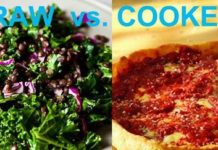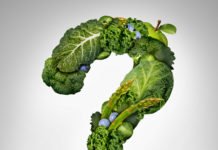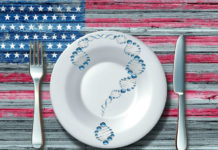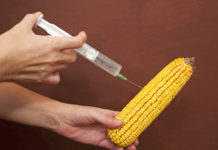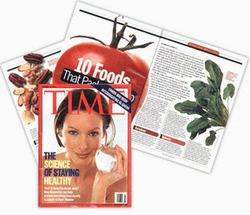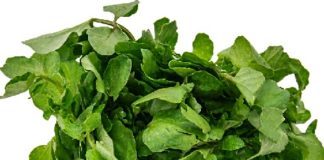“Food, of course, is a necessary ingredient for good health. But is it more than that? Can eating the right foods in the right combination actually prevent disease? In the past few years, research on the subject has exploded. Scientists have started to identify what may be hundreds-even thousands-of natural chemicals in foods that seem to have preventive powers. They aren’t just vitamins and minerals but a whole new bouquet of strange-sounding compounds-starting with the latest nutritional superstars, the phytochemicals.
“In the pages that follow, we’ve used this research to prepare a shopping list of 10 foods that pack a nutritional punch. Used correctly, they may have the power to prevent all kinds of serious ailments, including heart disease, diabetes, and even cancer. You may never look at a tomato the same way again.
“A word of warning: you can find many of these compounds in dietary supplements, but they might not do any good. ‘Food is very complex,’ says JoAnn Manson, chief of preventive medicine at Harvard’s Brigham and Women’s Hospital. ‘It may be the combination of antioxidants, phytochemicals and fiber the work together to confer health benefits.’
“Fortunately nature has given us a handy rule of thumb. Many of the very chemicals that make foods good for us are the ones that give them color, turning blueberries blue, spinach green, and carrots deep orange. For optimum health, scientists say, eat a rainbow of colors. Your plate should look like a box of Crayolas.”
There are lots of great quotes from other articles too, including a great article on exercise and another one on overweight kids. This issue is extremely important for helping us to share the benefits of whole, live foods! Buy as many as you can afford from your local newsstand and send them to all your friends and family! They’ need it!
Food, of course, is a necessary ingredient for good health. But is it more than that? Can eating the right foods in the right combination actually prevent disease? In the past few years, research on the subject has exploded. Scientists have started to identify what may be hundreds–even thousands–of natural chemicals in foods that seem to have preventive powers. These aren’t just vitamins and minerals but a whole new bouquet of strange-sounding compounds–starting with the latest nutritional superstars, the phytochemicals.
In the pages that follow, we’ve used this research to prepare a shopping list of 10 foods that pack a nutritional punch. That clove of garlic in your refrigerator? That jar of nuts in your pantry? Used correctly, they may have the power to prevent all kinds of serious ailments, including heart disease, diabetes and even cancer. You may never look at a tomato the same way again. (Or, as it turns out, a potato.)
A word of warning: you can find many of these compounds in dietary supplements, but they might not do any good. “Food is very complex,” says JoAnn Manson, chief of preventive medicine at Harvard’s Brigham and Women’s Hospital. “It may be the combination of antioxidants, phytochemicals and fiber that work together to confer health benefits.”
Fortunately, nature has given us a handy rule of thumb. Many of the very chemicals that make foods good for us are the ones that give them color, turning blueberries blue, spinach green and carrots deep orange. For optimum health, scientists say, eat a rainbow of colors. Your plate should look like a box of Crayolas.
Tomatoes
You can start by passing the ketchup. Several studies have linked the cooked tomatoes in ketchup, soups and sauces to a reduced risk of prostate cancer and other cancers of the digestive tract. Tomatoes contain lycopene, probably the most powerful antioxidant among the carotenoids, the compounds that turn fruits and veggies deep orange. It is so good at mopping up free radicals that Lycopene outperforms the best-known carotenoid of them all, beta-carotene. It is readily released from tomatoes by cooking and–good news for pizza lovers–it’s most easily absorbed when a small amount of oil is added. Like your tomatoes raw? That’s good too. They can be a valuable source of vitamin C.
Spinach
With his corncob pipe and his overdeveloped forearms, Popeye is hardly today’s poster child of fitness, but his legendary food preference still makes a lot of sense. Spinach is loaded with iron and folate, a B vitamin considered so important that it is now routinely added to flour. Folate not only prevents neural-tube defects in babies but also lowers blood levels of homocysteine, an amino acid that irritates blood vessels and is linked to heart disease. Just as impressive, spinach contains two phytochemicals, lutein and zeaxanthin, that seem to ward off macular degeneration, a leading cause of blindness. One cup of spinach contains just 41 calories and no fat, so you needn’t worry about any unsightly bulges in your forearms or anywhere else. Don’t like spinach? Try kale, Swiss chard or collard greens.
Red Wine
is it that the French can eat a diet rich in cheese and buttery sauces and still suffer less heart disease than Americans? The answer to the famous French paradox, say nutritionists, is French wine. The skins of the grapes used to make red wine contain supercharged antioxidants known as polyphenols, including one called resveratrol, which boosts HDL cholesterol (the good kind). Polyphenols, according to the latest research, may also inhibit the production of endothelin 1, a peptide that contributes to hardening of the arteries. But be careful. Wine may be great for the heart, but it’s been blamed for everything from cirrhosis of the liver to hemorrhagic stroke, fetal-alcohol syndrome and possibly breast cancer, so consumption should be limited to no more than several glasses a week.
Nuts
They’re loaded with fat and can be very salty, yet these filling little snack foods are nutritional powerhouses. That’s because the types of fat found in nuts–monounsaturated and polyunsaturated–are the good fats. When eaten instead of junk food high in saturated fats (like potato chips and doughnuts), nuts lower blood levels of triglycerides and LDL (bad) cholesterol while raising HDL (good) cholesterol–a perfect formula for preventing heart disease. Many nuts, such as pecans and walnuts, also contain a phytochemical called ellagic acid. In preliminary laboratory studies, ellagic acid seemed to trigger a process known as apoptosis, in which cancer cells kill themselves. Nuts provide another benefit: they contain vitamin E, a potent antioxidant that may help ward off heart disease and cancer. The downside? At about 150 calories per ounce, they are a sure ticket to the fat farm. Eat them by the handful, not the bowlful.
Who cares if Dubya’s dad hated it? The fact is, broccoli is one mean green. It boasts a fistful of phytochemicals, including sulforaphane and indole-3-carbinol, that may detoxify cancer-causing substances before they have a chance to cause harm. In women, indole-3-carbinol may turn the estrogen associated with breast cancer into a more benign form. A number of studies have linked regular consumption of cruciferous vegetables like broccoli to a reduced risk of breast, colon and stomach cancers. Broccoli is a rich source of beta-carotene, fiber and vitamin C (1 cup contains more C than an orange). The best way to unleash the nutrients is by cooking light and chewing hard. But if you simply can’t stand broccoli, try your luck with Brussels sprouts, cabbage and bok choy.
Oats
Sorry, Quaker, the fiber in oats and other cereals probably doesn’t prevent colon cancer. But there is still plenty to recommend in them. Raw in granola or cooked in porridge, oats consumed daily can help lower cholesterol. They contain beta-glucan, a spongy, soluble fiber that mops up the precursors of cholesterol in the intestines and whisks them out of the body. New evidence suggests that oats may also help lower blood pressure in hypertensive patients. Other benefits: the oat is one of the few grains that contain hard-to-find antioxidants, such as the vitamin E-like compounds called tocotrienols. Another plus is that the dietary fiber and protein in oats make you feel full fast. That should keep you away from more fattening foods and help control your weight.
Salmon that are free to roam the ocean enjoy a diet of fresh fish, which have eaten smaller fish, which in turn have eaten still smaller fish. At the bottom of that food chain are algae, the key to salmon’s health benefits. Algae boast a special kind of fat, known as omega-3 fatty acids, that seems to help the heart. Omega-3s prevent platelets in the blood from clumping together and sticking to arterial walls in the form of plaque. They also drive down triglycerides and LDL (bad) cholesterol. Researchers suspect that omega-3s may block the production of inflammatory substances linked to autoimmune diseases like rheumatoid arthritis and lupus. Even more tantalizing, preliminary reports suggest that omega-3s interact with the fatty layers that surround brain cells and, as fishy as it sounds, may somehow help protect brain cells from the diseases of aging, like Alzheimer’s. Other sources of omega-3s: herring, mackerel and bluefish.
Garlic
Oh, that stinking rose! What makes garlic–and your breath–smell so bad is precisely what makes it so healthful. The odor factors are sulfur-based compounds known as allyl sulfides. Health gurus promote garlic as a cure-all, which it certainly is not, but many scientists agree that allyl sulfides and other phytochemicals in garlic may help protect the heart. Studies show that the sulfides can reduce cholesterol and may make the blood less sticky. Scientists are fairly confident that garlic also has antibacterial and antifungal powers. Preliminary reports even suggest that garlic may block the parasites that cause malaria. On perhaps less firm footing is the theory that allyl sulfides can stop tumor growth, a notion so far borne out only in the petri dish.
To release garlic’s potent compounds, you need to smash, mash or mince it. Cooking it for a long time or at a high heat may destroy its beneficial substances, however. Another caution: cooked or raw, garlic can irritate the lining of sensitive stomachs.
Green Tea
In Asian societies green tea is consumed in about the same quantities as coffee is in the West. Green tea is loaded with polyphenols, a class of phytochemicals with 100 times the antioxidant punch of vitamin C. Laboratory experiments suggest that one group of polyphenols in green tea called catechins may inhibit the growth of new blood vessels, which some scientists think may help prevent cancer by depriving early tumors of nourishment. (Catechins may also prevent DNA damage caused by carcinogens from occurring in the first place.) Indeed, population studies in China link drinking green tea daily with a lowered risk of stomach, esophageal and liver cancers. Studies from Japan show that consuming 10 cups a day may reduce the risk of heart disease. If that much tea seems hard to swallow, consider using it is a mouthwash; reports suggest that swishing green tea around the mouth may inhibit cavity-causing bacteria. Applied to the skin of laboratory mice, it also seems to reduce the incidence of skin cancer. What about black tea? Made from the same leaves as green, though processed differently, it may be equally effective, scientists suspect.
Blueberries
Pint for pint, these little blue jewels may contain more antioxidants than any other fruit or vegetable. The most powerful health-promoting compounds in blueberries are anthocyanins, phytochemicals that belong to the flavonoid family. Besides combatting the free-radical damage linked to heart disease and cancer, anthocyanins may boost brainpower–at least in rats. When fed blueberry extract for nine weeks, elderly rats outperformed a control group at such tasks as navigating mazes and balancing on rotating logs. And when aging rats ate a blueberry-enriched diet for four months, they performed as well in memory tests as younger rats. Another blueberry benefit: like cranberries, they seem to fight off urinary-tract infections by preventing E. coli bacteria from adhering to the bladder wall.
And Now the Bad News: Potatoes
Potatoes are supposed to be one of the world’s greatest foods, filled with calcium, niacin, iron, vitamin C and plenty of carbohydrates. A diet of milk and potatoes, the textbooks say, will provide all the nutrients the human body needs. But there is trouble lurking beneath the skin. According to a controversial new theory, potatoes, eaten in large quantities by a population increasingly sedentary and overweight, may be a major contributor to America’s alarming rates of heart disease and diabetes.
The problem, according to Meir Stampfer, a nutrition professor at the Harvard School of Public Health, is potato starch. When you eat a potato and that starch hits the saliva in your mouth, its tightly bundled molecules immediately get turned into sugars, which make a beeline for the blood. “You ate a potato,” says Stampfer, “but your body is getting pure glucose.” The flood of blood sugar sets off a chain reaction. Insulin pours out of the pancreas. Triglycerides shoot up. HDL (good) cholesterol takes a dive. “It’s a perfect setup for heart disease and diabetes,” says Stampfer.
This is not just a potato problem. It’s also a problem with white bread, bagels and most white rice. But couch potatoes don’t have to give up their spuds altogether, as long as they eat them in moderation. Or they could switch to sweet potatoes and yams, which metabolize less rapidly and wreak less havoc with blood sugar.
TIME Magazine, January 21, 2002
Also Read:
A Diet Rich in Berries Protects Against Cancer, Heart Disease & Alzheimer’s!



